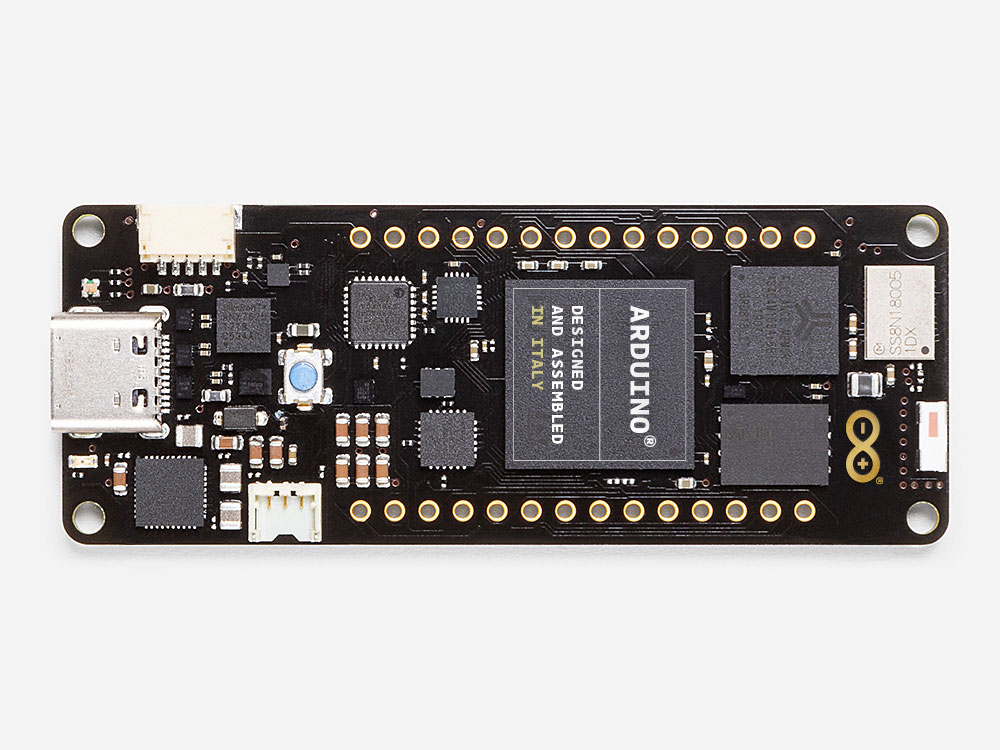Arduino announces the powerful new Arduino Portenta family
Designed for demanding industrial applications, AI edge processing and robotics, it features a new standard for open high-density interconnect to support advanced peripherals. The first member of the family is the Arduino Portenta H7 module – a dual-core Arm Cortex-M7 and Cortex-M4 operating at 480MHz and 240MHz, respectively, with industrial temperature range (-40 to 85°C) components. The Portenta H7 is capable of running Arduino code, Python and JavaScript, making it accessible to an even broader audience of developers.

The new Arduino Portenta H7 is now available for pre-order on the Arduino online store, with an estimated delivery date of late February 2020.
Overview:
Portenta H7 simultaneously runs high level code along with real time tasks. The design includes two processors that can run tasks in parallel. For example, is possible to execute Arduino compiled code along with MicroPython one, and have both cores to communicate with one another. The Portenta functionality is two-fold, it can either be running like any other embedded microcontroller board, or as the main processor of an embedded computer. Use the Portenta Carrier board to transform your H7 into an eNUC computer and expose all of the H7 physical interfaces.
Portenta can easily run processes created with TensorFlow Lite, you could have one of the cores computing a computer vision algorithm on the fly, while the other could be making low level operationis like controlling a motor, or acting as a user interface. Use Portenta when performance is key, among other cases, we envision it to be part of:
- High-end industrial machinery
- Laboratory equipment
- Computer vision
- PLCs
- Industry-ready user interfaces
- Robotics controller
- Mission-critical devices
- Dedicated stationary computer
- High-speed booting computation (ms)
Two Parallel Cores
H7’s main processor is a dual-core unit made of a Cortex M7 running at 480 MHz and a Cortex M4 running at 240 MHz. The two cores communicate via a Remote Procedure Call mechanism that allows calling functions on the other processor seamlessly. Both processors share all the on-chip peripherals and can run:
- Arduino sketches on top of the Arm Mbed OS
- Native Mbed applications
- MicroPython / JavaScript via an interpreter
- TensorFlow Lite
Graphics Accelerator
Probably one of the most exciting features of the Portenta H7 is the possibility of connecting an external monitor to build your own dedicated embedded computer with a user interface. This is possible thanks to the processor’s on-chip GPU, the Chrom-ART Accelerator. Besides the GPU, the chip includes a dedicated JPEG encoder and decoder.
A new standard for pinouts
The Portenta family adds two 80 pin high density connectors at the bottom of the board. This ensures scalability for a wide range of applications by simply upgrading your Portenta board to the one suiting your needs
On-board Connectivity
The onboard wireless module allows to simultaneously manage WiFi and Bluetooth connectivity. The WiFi interface can be operated as an Access Point, as a Station or as a dual mode simultaneous AP/STA and can handle up to 65 Mbps transfer rate. Bluetooth interface supports Bluetooth Classic and BLE. It is also possible to expose a series of different wired interfaces like UART, SPI, Ethernet, or I2C, both through some of the MKR styled connectors, or through the new Arduino industrial 80 pin connector pair.
USB-C Multipurpose Connector
The board’s programming connector is a USB-C port that can also be used to power the board, as a USB Hub, to connect a DisplayPort monitor, or to deliver power to OTG connected devices.
Multiple options in one board
Order the default Arduino Portenta H7 (codename H7-15EUNWAD) that comes with:
- 2MB SDRAM
- 16MB NOR Flash
- 10/100 Ethernet Phy
- USB HS
- NXP SE050C2 Crypto
- WiFi/BT Module
- Ceramic Antenna
- DisplayPort over USB-C
If you need more memory, Portenta H7 can host up to 64 MByte of SDRAM, and 128 MByte of QSPI Flash. Order it with an external UFL connector for adding a higher-gain antenna to the board. Decide between crypo-chips from Microchip and NXP. The board is highly customizable in volumes, ask our sales representatives for options.
Arduino also providing Portenta Carrier board that will add extra capabilities to your H7 board

The Portenta Carrier exposes all of the extra capabilities of the processor on your microcontroller board through connectors and peripherals that do not physically fit on it. There are connectors for USB, RJ-45, CAN bus, audio in and out lines, camera, DisplayPort, etc.
This design expands the default communication ports of Portenta boards to other wired and wireless protocols. Gigabit Ethernet will let you transform your board into a dedicated access point, a network drive, or even a serial-to-ethernet bridge. Adding a SIM card to the board makes it possible to connect to NBIoT or GPRS networks. Thanks to its LoRa® connectivity you can design your own gateway to host your wireless sensor network.
Adding an 8-bit camera sensor to the Portenta Carrier camera connector will help you implement any kind of computer vision application. And if the onboard computing power is not enough, you could enhance your board’s AI capabilities by adding state-of-the-art Machine Learning modules through the Carrier’s miniPCI connector (like Google’s Coral unit of computation).
Source: Arduino.cc
Please advise when application notes will become available for the Portenta H7 ?